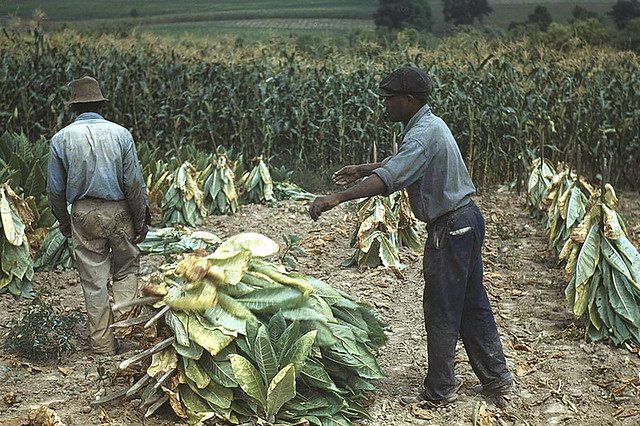If you missed the series introduction, you can read it here.

Tobacco is an elemental part of American history. Within five years of the founding of the colony at Jamestown, Virginia, the first white settlers were growing tobacco as a cash crop, and it was the economic foundation for how they survived. George Washington grew and sold tobacco. Or to be more precise, the workers in his fields grew tobacco. And thus it has ever been through the whole winding course of American history: slaves, migrants, poor dirt farmers, small-plot landowners, and others have worked the fields to grow this plant and turn it into money. This picture depicts a sight you can see anywhere tobacco is grown: tobacco farmers and workers taking advantage of any available ground — a small patch adjacent to a healthy stand of corn, as is shown here, or untillable land on an awkward rocky slope — and working it to yield this sturdy, reliable cash crop. Here, you see the oversized, beautiful, fragrant tobacco leaves, so full of the promise of cash. And so full of illness.


Visitor Comments
Two different methods were generally used to place the plant onto the 'tobacco stick'. The stick was about 4' in length by 1" by 1", with the ends tapered. The taper allowed one end to be driven into the ground about 5" in depth, while the other facilitated placing a sharpen metal cone, the spear, onto the other. The sticks were distributed in a manner to allow 5 plants to be placed on each stick, from first the row on one side and then the other. The plants were cut off about 5" above the ground with a sharp knife, we used a device called a Tomahawk Cutter, and then the plant was 'speared' onto the stick. After cutting the plants on their sticks were allowed to wilt over night, and then the next morning while the dew had brought the plants into order (order was the condition of the leaves when sufficient moisture allow the sticks to be handled without the leaves breaking off of the stalk of the plant) the sticks would be placed on available transport and then 'housed' in a barn for 'air curing' (the method used to cure the KY Burley tobacco pictured).
As a child I would make 50 cents an hour for dropping and driving sticks, as a teenager I made $1.00/ hour for cutting, transporting, and housing the plants (this was when I worked for other farmers, we were never paid in cash for working on our family farm). The other method of harvesting was by distributing the sticks between the rows, the plants were then cut and piled (5 to the stick) on the ground. The spearer then stood up a stick, placed the spear on top, speared a plant onto the stick, then another plant (the first two plants where then spread at about a 45 degree angle, one to the other, thus forming, with the stick, a tripod that would remain standing) until all 5 plants were speared.
After about 90 days of curing, the plants were removed from the barn and taken to a 'stripping room' where the leaves were stripped from the stalk, and then tied into 'hands' for sale. A hand of tobacco was the amount that you could hold by the base end of the leaf until it was about 2" in diameter (make the okay sign with your thumb and forefinger), then tied using another leaf folded and then wrapped around until finished with a half-hitch knot.